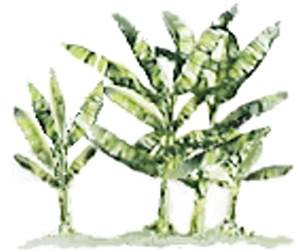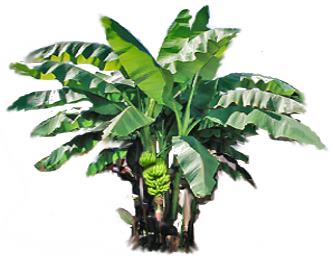The Abaca plant
belongs to the family of the banana plant (Musaceae family) and is indigenous to the Philippines. The banana plant and the abaca plant has a striking similarity in looks but the main difference is that the fruit of the abaca plant is inedible. Its fibre is known as the Manila Hemp. Abaca is not a hemp but since hemp was the main source of fibres for centuries, the abaca fibre was named Manila hemp. Abaca has been cultivated in the Philippines since the 1500s and became known worldwide in the 1800s mainly used as ropes in ship rigging.The abaca plant grows up to twenty feet when mature. About 2 to 4 times a year the trunk is cut down above the roots to harvest the fibres. New sprouts will grow from the roots soon after cutting. Leaf sheaths are then stripped and pulp is scrapped off to get the abaca fibre strands. To make ropes, the strands are twisted together. These strands are mainly composed of cellulose, pectin and lignin.
Superior qualities of abaca fibre:
-Extremely strong and durable-Resistant to salt water
-Can be made into many hard-wearing products
-Relatively cheap to produce
-Has a beautiful texture when made into hats and other products
-Biodegradable and eco-friendly
Products made from abaca fibre / Manila hemp: Rope, abaca paper abaca rug, abaca furniture, abaca dye mat, abaca carpet, manila envelope and countless other products.
http://www.philippineherbalmedicine.org/abaca.htm
Atis Fruit Information
Atis is the Philippine name for Sweet Sop and Sugar Apple. Atis is a relative to custard apple and belongs to the Annona family. Atis is native to Central America, the Caribbean and northern South America. Atis was introduced to the Philippines during the Spanish times.
Atis is a small tree that grows between 10 to 20 feet high when fully matured with oblong leaves and green heart-shaped fruits with polygonal tubercles. The atis fruit has a white, sweet flesh and black seeds.
The Atis tree is easy to grow. Just plant a seed on almost any soil and atis will grow. However, it requires tropical or near tropical weather. When planted, Atis will begin to bear fruit in about a year's time. It will bear fruit about 3 times a year and the sweetest fruits are those borne during the summer months.
Atis is a small tree that grows between 10 to 20 feet high when fully matured with oblong leaves and green heart-shaped fruits with polygonal tubercles. The atis fruit has a white, sweet flesh and black seeds.
The Atis tree is easy to grow. Just plant a seed on almost any soil and atis will grow. However, it requires tropical or near tropical weather. When planted, Atis will begin to bear fruit in about a year's time. It will bear fruit about 3 times a year and the sweetest fruits are those borne during the summer months.
Avocado Nutrition Information
(Persea americana)
Avocado is a fruit and a tree. It often said to be the most nutritious fruit in the world - and it is. Avocado provides more than 25 essential nutrients such as protein, potassium, vitamin E, C, B-vitamins, folic acid, iron, copper, phosphorus and magnesium, just to name a few. Avocado also provides calories for energy and beneficial phytochemicals such as beta-sitosterol, glutathione and lutein.
Avocado contains fat, that is why it is a good source of energy, but the fat in avocado is mostly monounsaturated. What should be avoided or reduced is saturated fat that is present in most dairy and animal products. In fact, avocado helps in the absorption of nutrients that are fat-soluble such as alpha and beta-carotene and lutein, when food containing this nutrients are eaten with avocado. Avocado is also high in fiber that is good for the digestive system and the heart.
Overall, avocado is considered a complete food. With vitamins, minerals, antioxidants, calories and fiber with no cholesterol and is sodium free. Avocado is ideal for growing up children, adults and even for babies, especially when blended with other fruits. For athletes, avocado is a nutritious energy booster to rev up the body's strength.
Avocado can be eaten as is, mixed with other fruits, as salad, a shake, baked in breads and even made into a dip. In the Philippines, ripe avocado is often eaten as a snack by scooping from flesh from the skin then mixed with a some sugar and milk or cream. It is simply delicious!
Avocado contains fat, that is why it is a good source of energy, but the fat in avocado is mostly monounsaturated. What should be avoided or reduced is saturated fat that is present in most dairy and animal products. In fact, avocado helps in the absorption of nutrients that are fat-soluble such as alpha and beta-carotene and lutein, when food containing this nutrients are eaten with avocado. Avocado is also high in fiber that is good for the digestive system and the heart.
Overall, avocado is considered a complete food. With vitamins, minerals, antioxidants, calories and fiber with no cholesterol and is sodium free. Avocado is ideal for growing up children, adults and even for babies, especially when blended with other fruits. For athletes, avocado is a nutritious energy booster to rev up the body's strength.
Avocado can be eaten as is, mixed with other fruits, as salad, a shake, baked in breads and even made into a dip. In the Philippines, ripe avocado is often eaten as a snack by scooping from flesh from the skin then mixed with a some sugar and milk or cream. It is simply delicious!
Avocado Nutrition Facts http://www.philippineherbalmedicine.org/avocado.htm
The banana plant is not a tree but is an herb belonging to the Musaceae family. Bananas don't have a woody trunk like a tree but has what is called a "pseudostem". Both the plant and the fruit are called bananas. This perennial plant is native to southeast Asia but now grows worldwide specially in the tropics. Bananas can grow up to 8 meters tall but the average height is between 3 and 5 meters.
There are many varieties of bananas but generally, they can be categorized into sweet bananas (yellow when ripe) and the cooking bananas (green). Most bananas traded worldwide are of the sub-group of the sweet variety called: Cavendish - mainly because of its long shelf life.
In some African, South American and Asian countries, green bananas serve as a staple food, (akin to potatoes) specially in poor agricultural areas where bananas serve as the staple while waiting for the harvest season. Worldwide, bananas rank 4th as the most consumed food after rice, wheat and corn.
A banana plant bears only one bunch in its lifespan, before it dies, offshoots grow from the "rhizome" -the base of the pseudostem. A bunch consist of clusters with up to 20 tiers - a tier is called a hand with up to 20 banana fruits in each hand.
Eaten raw or cooked, bananas are very nutritious. It is a good source of carbohydrates, fibre, potassium, vitamin A and vitamin C.
Products made from the banana plant:
-Banana Chips - both the green and yellow bananas can be used to produce banana chips but green is preferable. The fruit is pealed, thinly sliced (sometimes brown sugar id added) then fried.-Banana Flour - the fruit (any variety) is dried then is grounded into powder and used as flour. The flour can be made into banana bread, cakes, etc.
-Banana Alcohol - bananas are allowed to ripe, juiced, then fermented. The beer like beverage, which is low in alcohol content is popular in Eastern and Central Africa.
-Banana Catsup - instead of tomatoes, the banana is used to make catsup, in the Philippines, banana catsup is commercially produced for domestic consumption & for export for many years.
-Banana Clothing - the fibre from the trunk of the banana or pseudostem is dried, processed, dyed and made into exotic clothing. In 2002 a Japanese company, Nisshinbo Industries introduced a denim like clothing made from the stems of bananas. Clothing made from banana fibers can "breath", absorbs water well and is easy to dry.
In addition to the above, bananas are also made into purée, juices and shakes. Banana fibers are made into different types of products. In many countries, banana fibers are made into: bags, hats, belts, paper, shoes, slippers, picture frames, place mats, greeting cards, fashion accessories, home decor and countless other products. http://www.philippineherbalmedicine.org/banana.htm
Philippine banana plant industry:
The world production of bananas per year is valued (estimate) at US$ 5 Billion. The Philippines is the 5th largest exporter of bananas in the world after India, Ecuador, Brazil and China (2002 figures). The Philippines produces a about 3.5 metric tons of bananas (est. value U.S. 700 Million in 2004) and yearly exports more than US$ 200 Million worth of bananas. This is made possible because of the favorable climate in the Philippines and that 382,491 hectares or half of the Philippines' land area planted with fruits are planted with bananas.Banana production not only earns much needed dollars for the country but more importantly, it generates employment to thousands of Filipinos and greatly contributes to the Philippine economy.



No comments:
Post a Comment